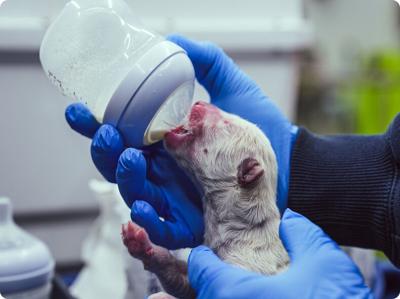In a twist that seems pulled straight from the pages of fantasy, dire wolves—long believed to be extinct for over 10,000 years—are making a stunning return, thanks to groundbreaking advancements in de-extinction science. Colossal Biosciences, a biotechnology company focused on species revival, announced the birth of the world’s first de-extinct dire wolves, a milestone in synthetic biology and conservation efforts.
The achievement is not merely a genetic party trick; it’s the result of years of cutting-edge research in CRISPR gene editing and ancient DNA recovery. Scientists began by extracting preserved genetic fragments from dire wolf remains—bones and teeth excavated from fossil-rich sites like the La Brea Tar Pits in Los Angeles. These ancient DNA sequences, though incomplete, offered a crucial genetic blueprint. The team then compared these fragments with the genomes of modern relatives such as gray wolves, coyotes, and domestic dogs to reconstruct a viable genome. Because dire wolves are not closely related to today’s gray wolves—diverging nearly 6 million years ago—the process wasn’t as simple as tweaking a few genes. After a successful gestation, the first pups were born—creatures that are genetically distinct from any living species, yet designed to mimic the dire wolves that once roamed Ice Age America.
Other animals under consideration for de-extinction include the woolly mammoth, dodo bird, and the Tasmanian tiger, or thylacine.
The cultural resonance of dire wolves has only amplified the public fascination. Immortalized in popular media as the loyal and fierce companions of the Stark children in Game of Thrones, they’ve become more than extinct predators—they’re symbols of ancient strength and mystery. George R.R. Martin, author of the beloved fantasy series, expressed his astonishment, calling the development "mind-blowing" and adding that while his direwolves were fictional and magical, the real-world science behind these new creatures is equally incredible.
Still, the process is not without controversy. As Smithsonian Magazine points out, these animals are not pure dire wolves. Rather, they are “proxy species”—animals designed to be as genetically and behaviorally close as possible to their extinct counterparts. Critics question whether such proxies should be classified as true de-extinction and raise concerns about their ecological impact and welfare in the modern world.
For now, though, the focus remains on the profound scientific achievement: dire wolves, long relegated to natural history museums and fantasy novels, are once again walking the Earth. Whether heralded as visionary or cautionary, their return marks a new chapter in the complex relationship between science, nature, and imagination.
Sources: Yahoo News – Game of Thrones Author George R.R. Martin Reacts to Real Dire Wolves; Business Wire – Colossal Announces World’s First De-Extinction Birth of Dire Wolves; Smithsonian Magazine – Have Dire Wolves Really Been Brought Back to Life?; La Brea Tar Pits








(0) comments
Welcome to the discussion.
Log In
Keep it Clean. Please avoid obscene, vulgar, lewd, racist or sexually-oriented language.
PLEASE TURN OFF YOUR CAPS LOCK.
Don't Threaten. Threats of harming another person will not be tolerated.
Be Truthful. Don't knowingly lie about anyone or anything.
Be Nice. No racism, sexism or any sort of -ism that is degrading to another person.
Be Proactive. Use the 'Report' link on each comment to let us know of abusive posts.
Share with Us. We'd love to hear eyewitness accounts, the history behind an article.